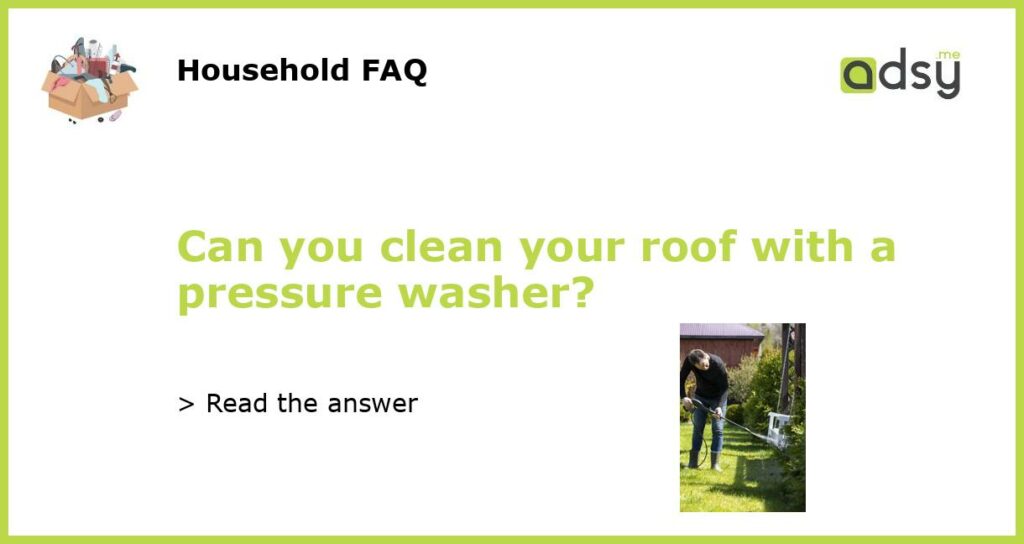Yes, you can clean your roof with a pressure washer
Pressure washing is a popular method for cleaning various surfaces, including roofs. With the high-powered spray, a pressure washer can effectively remove dirt, grime, moss, and other debris from your roof. However, it’s important to approach this task with caution to avoid causing any damage.
The benefits of using a pressure washer for roof cleaning
Cleaning your roof with a pressure washer offers several benefits. Firstly, it’s a quick and efficient method. The high-pressure water stream can wash away years of built-up dirt in a matter of minutes. This saves you time and effort compared to using traditional cleaning methods. Secondly, a pressure washer can reach difficult-to-access areas, such as roof corners and crevices, ensuring a thorough cleaning. Lastly, pressure washing can improve the overall appearance of your roof, making it look clean and rejuvenated.
Precautions when pressure washing your roof
While pressure washing is an effective cleaning method, it can also cause damage if not done correctly. Here are some precautions to keep in mind:
1. Use the proper pressure setting: Adjust the pressure washer’s settings to a low or medium pressure to avoid damaging the roof materials. High pressure can strip off shingles, tiles, or other roofing materials, leading to leaks and further damage.
2. Maintain a safe distance: Stand a safe distance away from the roof surface when pressure washing. This distance helps prevent the water stream from being too concentrated or forceful, which could cause damage. A distance of 6-8 feet is usually recommended.
3. Use the correct nozzle: Choose a wide-angle nozzle or a nozzle specifically designed for roof cleaning. These nozzles disperse the water stream over a larger area, minimizing the risk of excessive pressure on a single spot.
4. Be mindful of fragile areas: Pay attention to any fragile or sensitive areas on your roof, such as loose or damaged shingles. Avoid spraying directly onto these areas to prevent further damage.
When to hire a professional
While pressure washing your roof can be a DIY task, there are situations where it’s best to hire a professional. Consider the following scenarios:
1. Steep or high roofs: If your roof has a steep or high pitch, it’s safer to hire a professional who is experienced in working at heights. This ensures your safety and minimizes the risk of accidents.
2. Delicate roofing materials: Some roofing materials, such as slate or wood shakes, are more fragile and require extra care during cleaning. A professional roof cleaner will have the knowledge and expertise to handle these materials without causing damage.
3. Lack of experience or equipment: If you’re unsure about pressure washing or don’t have access to the necessary equipment, it’s best to leave the job to professionals. They have the right tools and experience to clean your roof effectively and safely.
Remember, hiring a professional may incur additional costs, but it ensures the job gets done properly without the risk of damage to your roof or personal injury.
Additional roof cleaning considerations
Pressure washing is not the only method for cleaning your roof. Depending on your roof’s condition and the type of dirt or debris present, other cleaning methods may be more appropriate. For example, gentle scrubbing with a soft brush, using a cleaning solution specifically formulated for roofs, can be an effective alternative to pressure washing.
Additionally, preventative measures can help keep your roof clean for longer periods. Regular maintenance, such as removing overhanging tree branches and cleaning out gutters, can prevent the accumulation of debris on your roof, reducing the frequency of deep cleaning.
In conclusion, pressure washing can clean your roof effectively and efficiently, but it must be done with caution. Adhering to the necessary precautions and knowing when to call in a professional can ensure your roof stays in good condition without any unnecessary damage or safety risks.






